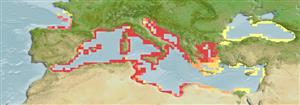Classification / Names
Common names | Synonyms | Catalog of Fishes (gen., sp.) | ITIS | CoL | WoRMS | Cloffa
Actinopterygii (ray-finned fishes) >
Perciformes (Perch-likes) >
Labridae (Wrasses)
Etymology: Symphodus: Greek, syn, symphysis = grown together + Greek, odous = teeth (Ref. 45335).
Issue
See nomenclatural details in Eschmeyer (CofF ver. Oct. 2012: Ref. 92135).
Environment / Climate / Range
Ecology
Marine; reef-associated; depth range 1 - 30 m. Subtropical, preferred ?; 47°N - 30°N, 6°W - 42°E
Eastern Atlantic: throughout the Mediterranean, Black Sea and Sea of Azov.
Length at first maturity / Size / Weight / Age
Maturity: Lm 4.0 range ? - ? cm
Max length : 12.0 cm SL male/unsexed; (Ref. 4742); max. reported age: 5 years (Ref. 4742)
Adults are found near rocks and eel-grass beds. A nest of seaweed (Cystoseria) built and kept by male. Feed on bryozoans, hydroids, tubicolous, worms, shrimps, amphipods and mollusks. Males grow faster than females (Ref. 4742). Undergoes sex reversal (Ref. 4742). Oviparous, distinct pairing during breeding (Ref. 205).
Undergoes sex reversal (Ref. 4742). Oviparous, distinct pairing during breeding (Ref. 205). Males build dish shaped nests and guard the eggs (Ref. 205).
Quignard, J.-P. and A. Pras, 1986. Labridae. p. 919-942. In P.J.P. Whitehead, M.-L. Bauchot, J.-C. Hureau, J. Nielsen and E. Tortonese (eds.) Fishes of the north-eastern Atlantic and the Mediterranean. UNESCO, Paris. Vol. 2. (Ref. 4742)
IUCN Red List Status (Ref. 115185)
CITES (Ref. 94142)
Not Evaluated
Threat to humans
Harmless
Human uses
Aquarium: commercial
More information
ReferencesAquacultureAquaculture profileStrainsGeneticsAllele frequenciesHeritabilityDiseasesProcessingMass conversion
Tools
Special reports
Download XML
Internet sources
Estimates of some properties based on models
Phylogenetic diversity index (Ref.
82805): PD
50 = 0.5005 [Uniqueness, from 0.5 = low to 2.0 = high].
Bayesian length-weight: a=0.01202 (0.00793 - 0.01824), b=3.13 (3.01 - 3.25), in cm Total Length, based on LWR estimates for this species & Genus-body shape (Ref.
93245).
Trophic Level (Ref.
69278): 3.5 ±0.0 se; Based on diet studies.
Resilience (Ref.
69278): Medium, minimum population doubling time 1.4 - 4.4 years (K=0.64-0.95; tm=1-2; tmax=5).
Prior r = 1.72, 2 SD range = 1.24 - 2.38, log(r) = 0.54, SD log(r) = 0.16, Based on: 1 K, 3 tgen, 1 tmax, records
Vulnerability (Ref.
59153): Low vulnerability (14 of 100) .
